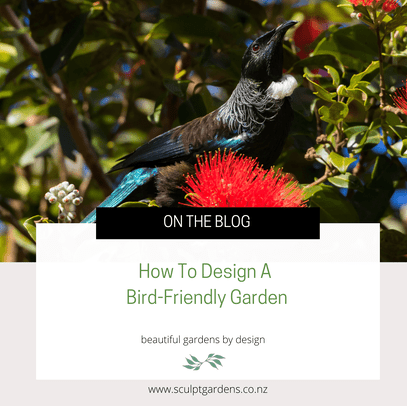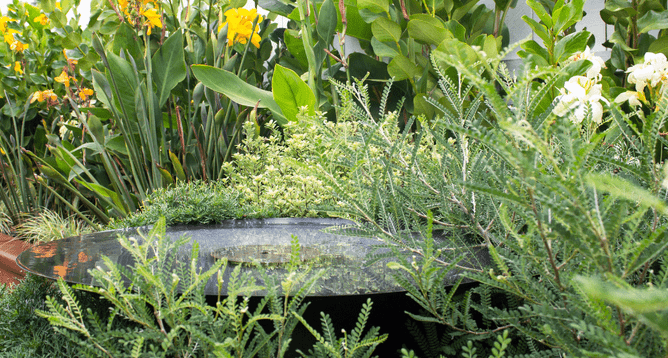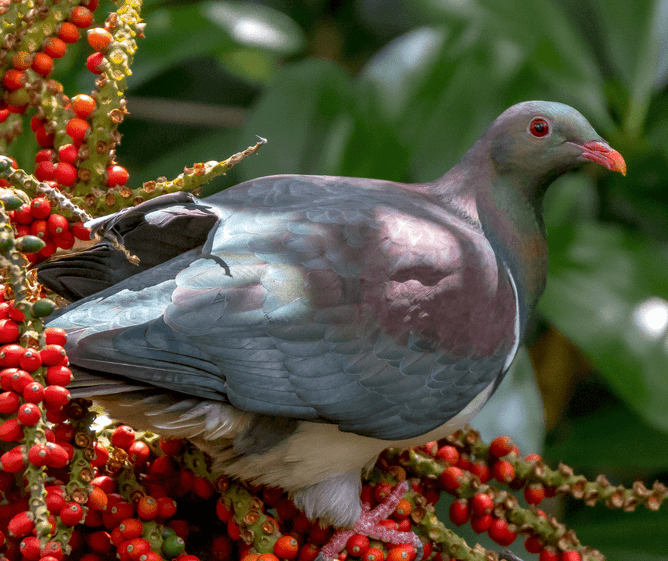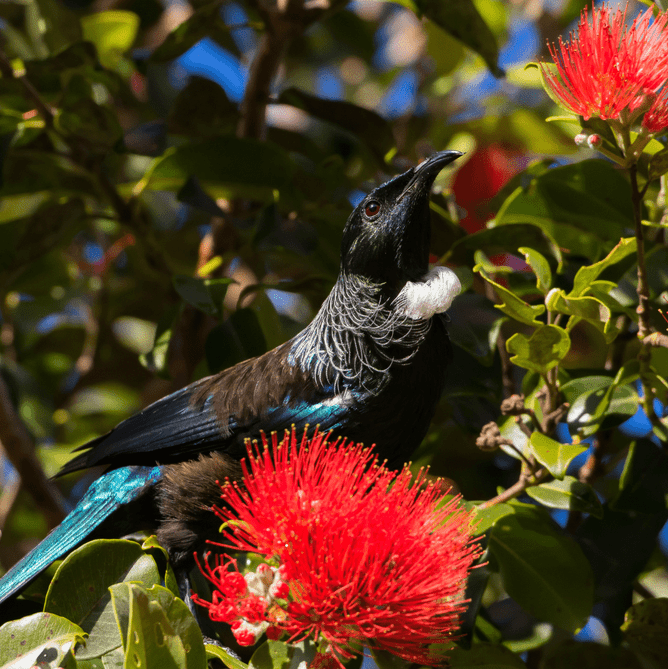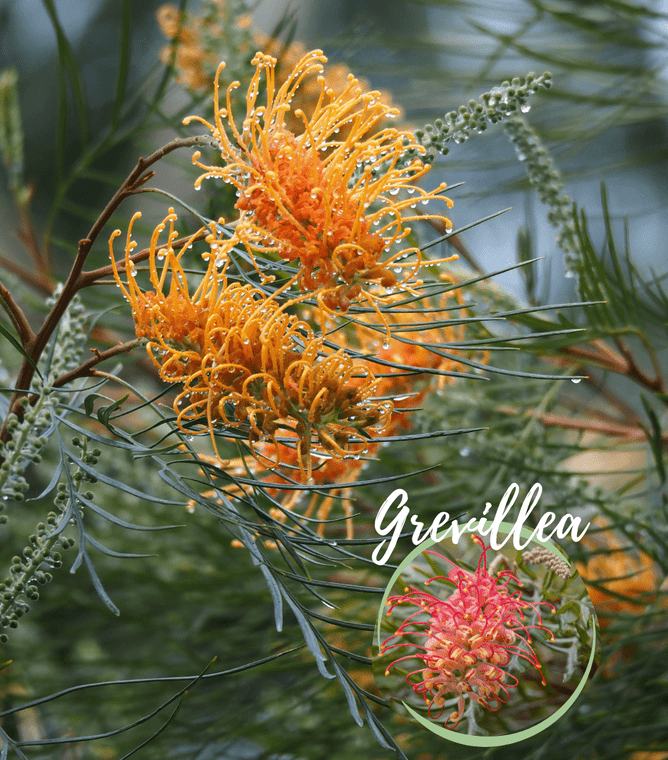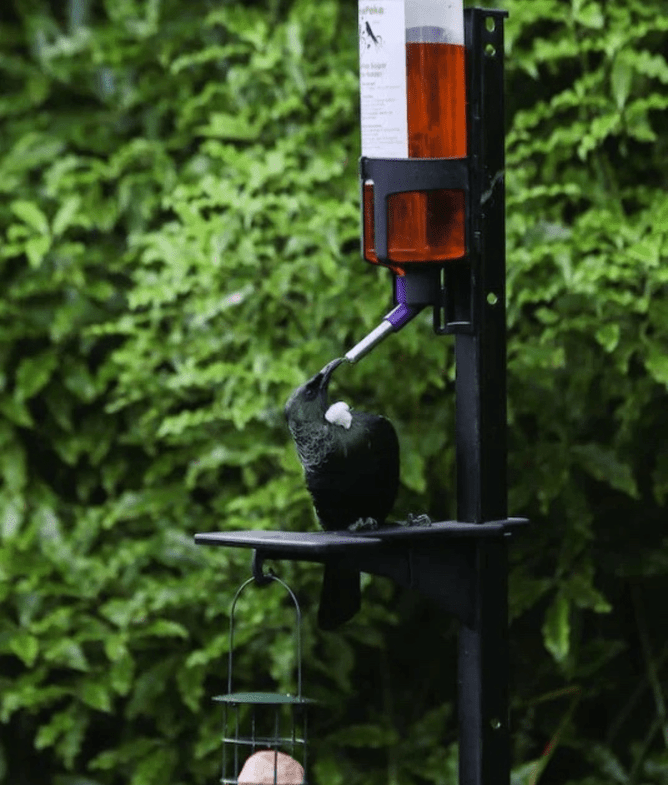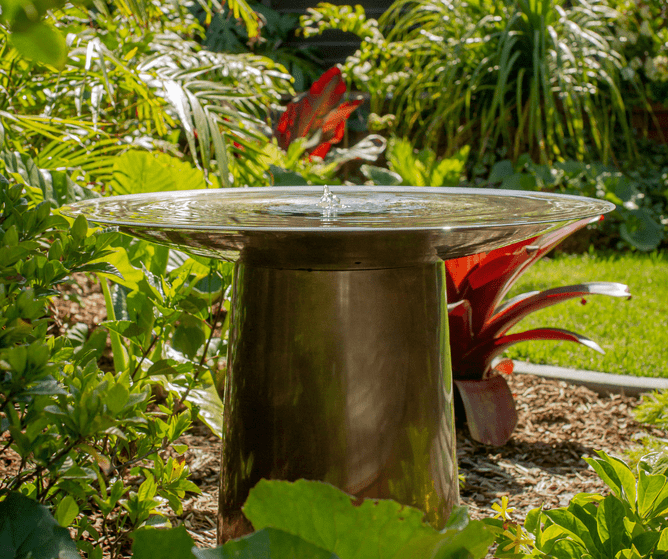Here at Sculpt, we are strong believers in boosting the presence of wildlife and nature in people's lives due to the significant implications it has on our environment, wildlife and mental health.
A study conducted by Kings College London found that "seeing or hearing birds is associated with an improvement in mental well-being that can last up to eight hours".
Providing a suitable and safe environment to encourage native birds in your garden is an excellent way to give back to Papatūānuku.
Here are some of my top recommendations for designing a bird-friendly landscape.
The garden pictured above was designed by Sculpt Gardens, with the intent to create a haven where birds and bees thrive. The portfolio can be viewed here.
Why Attract Birds?
Birds play a vital role in ecology and the continuation of our New Zealand native plants.
Our native birds, such as the Tui, feed on nectar from our native plants, pollinating flowering plants and dispersing the seeds of trees.
Many of our native trees are unable to carry out the process of pollination or seed dispersal without the help of native birds, making them dependent on birds for regeneration.
When a bird consumes seed, by the time it has been digested it will be dropped in a location far from the original plant, resulting in the potential colonisation of a new zone.
Creating a garden that provides shelter, food and nesting for native birds and allows native plants to flourish is a significant way to demonstrate manaakitanga to our environment.
A kererū, or New Zealand pigeon, feeds on the berries of a Nīkau palm.
Nature's Food
Planting a range of native plants to provide a mix of nectar, seeds and berries is a great start. Many of our natives only flower or fruit for a short season, so mixed-up groups of plants with varying heights providing diversity are ideal.
Puriri is a very important tree for our native birds in the upper North Island, providing a constant year-round food supply of nectar, fruit and seeds.
There is often a lack of native nectar sources in the winter which is one reason people supply feeding stations, however there are a range of exotic species such as Grevillea, Bottlebrush and Aloe, that prolifically flower in winter and can be a great natural supplement.
The relationship between the plants and birds is mutual, as the plants can continue regeneration whilst supplying food for the birds.
Ensuring your garden includes a natural seasonal food selection will encourage birds to your home.
Rather than removing leaf matter from your garden beds, leave it to decompose and turn to mulch. Not only does this feed the soil, but it attracts insects that birds such as the beautiful Pīwakawaka (Fantail) feed on.
If your garden sees significant leaf drop, remove leaves that are cluttering the base of plants and make a pile in a designated area where they can break down.
A Tui perched on the flower of a Pohutakawa.
What To Plant
When selecting plants for your bird-friendly garden, research what plants are best suited to your local climate and native to your area.
It can be beneficial to include some exotics to help provide year-round food. There are many South African and Australian plants that suit our climate and are long flowering that can complement our natives.
At Sculpt, we have a keen interest in floral, biodiverse and productive gardens that attract birds and bees into your New Zealand garden. Here are a few native plant suggestions that we often use to attract birds into your garden.
Kōwhai - provides nectar.
Puriri - nectar, seeds and fruit.
Nīkau - fruit and seeds.
Tarata (lemonwood) - nectar, fruit and seeds.
Harakeke (flax) - nectar.
Kawakawa - fruit and seeds.
Karamū (Coprosma) - fruit and seeds.
Titoki - fruit and seeds.
Kōtukutuku (tree fuschia) - nectar, fruit and seeds.
Puahou (five finger) - fruit and seeds.
Manuka or Kanuka - provides great shelter for birds, and attracts insects for the Pīwakawaka.
Cabbage Tree - pollen and fruit.
Muhlenbeckia (pōhuehue) - provides fruit and seeds, and attracts insects and skinks.
Corokia (korokio) - fruit and seeds.
Some exotic options that our feathered friends love include (but are not limited to):
Grevillea - nectar (some flower intermittently all year round!)
Banksia integrifolia - nectar and pollen.
Tagasaste (Cytisus proliferus) - nectar and pollen, fixes nitrogen in the soil.
Verbena bonariensis - nectar and pollen.
Callistemon (Bottlebrush) - nectar and pollen.
Prunus campanulata 'Mimosa' or Prunus campanulata 'Pink Cloud' - nectar and pollen.
Aloes - winter flowering.
Fruit trees such as plum, feijoa, apple, orange, mandarin, pear etc.
Featured is a beautiful exotic plant that is very popular among our native birds. Grevillea is a stunning option that often blooms year-round and available in many colours and varieties.
Options For Supplementing Food
Before you set up a feeding station for your birds, ensure the area is safe from pests or cats that may cause harm. Although it does not guarantee protection, adding a bell to your cat's collar and keeping them inside at night are great forms of prevention. Positioning your station where it is not too close to a window is also sensible, as the reflection can confuse.
Avoid feeding seeds, grains and bread as these attract introduced birds that out-compete natives for food, an alternative is to provide fruit.
Providing a water source for birds is a great way to help ensure a successful breeding season come spring. Adding sugar to the water benefits nectar-sipping species, particularly over winter when nectar is limited. Ensure you clean your feeders regularly to avoid the spread of diseases.
A simple dish raised can be used, or feeding stations can be purchased, like this one pictured below by Peka Peka.
It can take time for the birds to take an interest in your feeding station, so don't be disheartened if they are taking caution.
Making your station appear as natural as possible will help birds to adjust, such as by positioning it near trees or greenery.
This feeding station by Peka Peka provides the perfect place for this Tui to enjoy a drink of sugar water.
Bird Baths
Bird baths are not only attractive features in a garden, but they provide excellent benefits for birds.
A benefit of bird baths is an excellent way to ensure birds and other beneficial insects have a clean water source. As well as this, bathing allows birds to remove the excess dust and dirt in their feathers, and particularly in the warmer months, enables them to regulate and cool their body temperature. By supplying an area to bathe in, birds are also able to preen which is beneficial for the well-being of birds. This is a natural process where using their beaks they remove oils, parasites and other harmful things.
When purchasing a bird bath, ensure you check the depth, as the safe depth for birds to bathe in is 2 inches or less. If you do find that your bath is too deep, a simple solution is to find some flat rocks and place them in the bath.
Not only will the birds reap the benefits of a bird bath, but your well-being is likely to improve amidst the peace and tranquillity of a water feature.
Designed by Sculpt Gardens, this ripple dish is situated amongst lush tropical planting. The portfolio can be viewed here.
With this information, we hope that you are inspired to design a paradise that can be shared with our native birds. If you would love some help with designing your bird attracting garden, book a garden consultation with our team today!
